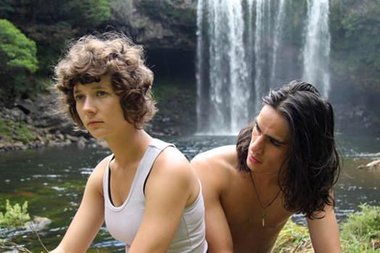John Hurrell – 3 December, 2012
Against Darwin's scathing comments Hipkins' 16 mm colour negative film presents as a foil a bi-cultural romance, alluding to films from the early fifties such as John O'Shea's Broken Barrier, and recreating visits to some of the sites Darwin mentions.
Gavin Hipkins is well known for the scholarly research that underpins his subtly mysterious and/or carefully layered photographs, so when in a new move he moves beyond static, two dimensional, imagery to embrace film-making that deals with New Zealand colonial history, it piques interest.
This Fine Island uses for a voiceover selections from Charles Darwin’s diary written during his nine day visit to the Bay of Islands in 1835. He had been away on the Beagle for four years, came from Tahiti to Aotearoa and found the activity in the bay brutal and squalid. Horrified by the people he met, he found the English “the very refuse of society”, and the Maori (“a more warlike race could not be found”) devoid of “any charm or simplicity”.
Against Darwin’s scathing comments Hipkins’ 16 mm colour negative film presents as a foil a bi-cultural romance, alluding to films from the early fifties such as John O’Shea’s Broken Barrier, and recreating visits to some of the sites Darwin mentions. He also splices in amongst the shots of native bush - in typical Hipkins fashion - images of mammals, birds and reptiles (not necessarily from here) taken from natural history illustrations that perpetuated the taxonomies Darwin helped create, and which he articulated in his theories three years later.
I must admit I don’t find Hipkins that interesting as a moving image artist. Darwin’s visit has now been much discussed in the mainstream media, especially with an exhibition at Auckland Museum a couple of years ago, so for the film to succeed the imagery and sound need to be really dynamic - beyond the historical content of the voiceover. They seem too restrained and perhaps (as a romance) a bit dull, even sugary - despite the insertion of countering elements like the zoological illustrations (lots of sharp claws and cruel beaks) and bawdy nineteenth century folk tunes.
Oddly the best cinematography is slightly slo-mo and almost static: framing bookends that bracket Hipkins’ larger, post colonial project; shots with a hallucinatory intensity that match his best ‘unhomely’ photographs. An early scene - rolling waves on a beach swathed in falling rain - reveals curving windswept water flicked sideways, with rhythms akin to the most ornate Bill Hammond ‘nature’ painting. And at the end, Joe Dekker-Reihana’s character is juggling hacky sacks that appear to rise unassisted, hovering in the air suspended before descending. These soft coloured bags, like some other shots of looking up at Dekker-Reihana’s ribbed tent roof, have a strange ambiguity, the former with curtailed motion, the latter with flattened spatial depth.
The voiceover and folk music (from Jenny Lange and Dean Roberts) control the pace of this twelve minute film, but despite the staccato insertions of the subtly violent black and white illustrations it gets a little monotonous. We get a taste of the sensibility Hipkins is known for - but not enough.
John Hurrell


 Advertising in this column
Advertising in this column Two Rooms presents a program of residencies and projects
Two Rooms presents a program of residencies and projects



This Discussion has 0 comments.
Comment
Participate
Register to Participate.
Sign in
Sign in to an existing account.